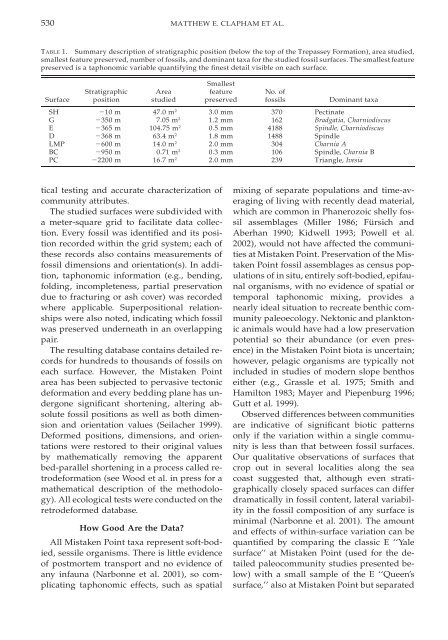Paleoecology of the oldest known animal communities: Ediacaran ...
Paleoecology of the oldest known animal communities: Ediacaran ...
Paleoecology of the oldest known animal communities: Ediacaran ...
Create successful ePaper yourself
Turn your PDF publications into a flip-book with our unique Google optimized e-Paper software.
530 MATTHEW E. CLAPHAM ET AL.<br />
TABLE 1. Summary description <strong>of</strong> stratigraphic position (below <strong>the</strong> top <strong>of</strong> <strong>the</strong> Trepassey Formation), area studied,<br />
smallest feature preserved, number <strong>of</strong> fossils, and dominant taxa for <strong>the</strong> studied fossil surfaces. The smallest feature<br />
preserved is a taphonomic variable quantifying <strong>the</strong> finest detail visible on each surface.<br />
Surface<br />
Stratigraphic<br />
position<br />
Area<br />
studied<br />
Smallest<br />
feature<br />
preserved<br />
No. <strong>of</strong><br />
fossils<br />
Dominant taxa<br />
SH<br />
G<br />
E<br />
D<br />
LMP<br />
BC<br />
PC<br />
10 m<br />
350 m<br />
365 m<br />
368 m<br />
600 m<br />
950 m<br />
2200 m<br />
47.0 m 2 3.0 mm<br />
7.05 m 2 1.2 mm<br />
104.75 m 2 0.5 mm<br />
63.4 m 2 1.8 mm<br />
14.0 m 2 2.0 mm<br />
0.71 m 2 0.3 mm<br />
16.7 m 2 2.0 mm<br />
370<br />
162<br />
4188<br />
1488<br />
304<br />
106<br />
239<br />
Pectinate<br />
Bradgatia, Charniodiscus<br />
Spindle, Charniodiscus<br />
Spindle<br />
Charnia A<br />
Spindle, Charnia B<br />
Triangle, Ivesia<br />
tical testing and accurate characterization <strong>of</strong><br />
community attributes.<br />
The studied surfaces were subdivided with<br />
a meter-square grid to facilitate data collection.<br />
Every fossil was identified and its position<br />
recorded within <strong>the</strong> grid system; each <strong>of</strong><br />
<strong>the</strong>se records also contains measurements <strong>of</strong><br />
fossil dimensions and orientation(s). In addition,<br />
taphonomic information (e.g., bending,<br />
folding, incompleteness, partial preservation<br />
due to fracturing or ash cover) was recorded<br />
where applicable. Superpositional relationships<br />
were also noted, indicating which fossil<br />
was preserved underneath in an overlapping<br />
pair.<br />
The resulting database contains detailed records<br />
for hundreds to thousands <strong>of</strong> fossils on<br />
each surface. However, <strong>the</strong> Mistaken Point<br />
area has been subjected to pervasive tectonic<br />
deformation and every bedding plane has undergone<br />
significant shortening, altering absolute<br />
fossil positions as well as both dimension<br />
and orientation values (Seilacher 1999).<br />
Deformed positions, dimensions, and orientations<br />
were restored to <strong>the</strong>ir original values<br />
by ma<strong>the</strong>matically removing <strong>the</strong> apparent<br />
bed-parallel shortening in a process called retrodeformation<br />
(see Wood et al. in press for a<br />
ma<strong>the</strong>matical description <strong>of</strong> <strong>the</strong> methodology).<br />
All ecological tests were conducted on <strong>the</strong><br />
retrodeformed database.<br />
How Good Are <strong>the</strong> Data?<br />
All Mistaken Point taxa represent s<strong>of</strong>t-bodied,<br />
sessile organisms. There is little evidence<br />
<strong>of</strong> postmortem transport and no evidence <strong>of</strong><br />
any infauna (Narbonne et al. 2001), so complicating<br />
taphonomic effects, such as spatial<br />
mixing <strong>of</strong> separate populations and time-averaging<br />
<strong>of</strong> living with recently dead material,<br />
which are common in Phanerozoic shelly fossil<br />
assemblages (Miller 1986; Fürsich and<br />
Aberhan 1990; Kidwell 1993; Powell et al.<br />
2002), would not have affected <strong>the</strong> <strong>communities</strong><br />
at Mistaken Point. Preservation <strong>of</strong> <strong>the</strong> Mistaken<br />
Point fossil assemblages as census populations<br />
<strong>of</strong> in situ, entirely s<strong>of</strong>t-bodied, epifaunal<br />
organisms, with no evidence <strong>of</strong> spatial or<br />
temporal taphonomic mixing, provides a<br />
nearly ideal situation to recreate benthic community<br />
paleoecology. Nektonic and planktonic<br />
<strong>animal</strong>s would have had a low preservation<br />
potential so <strong>the</strong>ir abundance (or even presence)<br />
in <strong>the</strong> Mistaken Point biota is uncertain;<br />
however, pelagic organisms are typically not<br />
included in studies <strong>of</strong> modern slope benthos<br />
ei<strong>the</strong>r (e.g., Grassle et al. 1975; Smith and<br />
Hamilton 1983; Mayer and Piepenburg 1996;<br />
Gutt et al. 1999).<br />
Observed differences between <strong>communities</strong><br />
are indicative <strong>of</strong> significant biotic patterns<br />
only if <strong>the</strong> variation within a single community<br />
is less than that between fossil surfaces.<br />
Our qualitative observations <strong>of</strong> surfaces that<br />
crop out in several localities along <strong>the</strong> sea<br />
coast suggested that, although even stratigraphically<br />
closely spaced surfaces can differ<br />
dramatically in fossil content, lateral variability<br />
in <strong>the</strong> fossil composition <strong>of</strong> any surface is<br />
minimal (Narbonne et al. 2001). The amount<br />
and effects <strong>of</strong> within-surface variation can be<br />
quantified by comparing <strong>the</strong> classic E ‘‘Yale<br />
surface’’ at Mistaken Point (used for <strong>the</strong> detailed<br />
paleocommunity studies presented below)<br />
with a small sample <strong>of</strong> <strong>the</strong> E ‘‘Queen’s<br />
surface,’’ also at Mistaken Point but separated

















